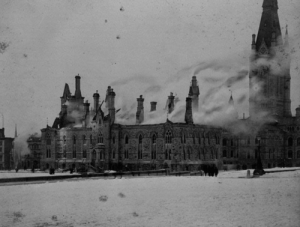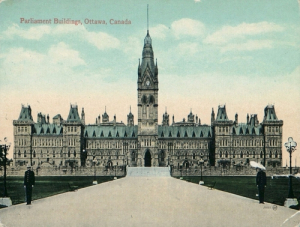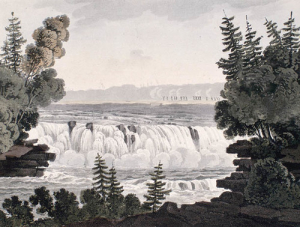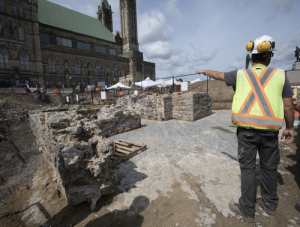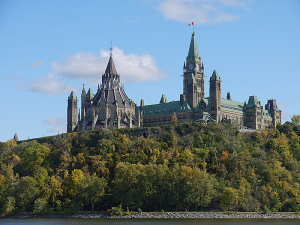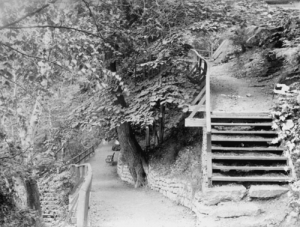The Bells of the Peace Tower
We began our speaker session of March 22, 2025 at the Main Branch of the Ottawa Public Library on a somber note as Ben Weiss informed us of the unexpected death of Jamie Bramburger who had been our guest speaker just one month earlier. All of us at the Historical Society of Ottawa extend our condolences to Jamie’s family, friends and colleagues.
As March 7, 2025 marked the 225th anniversary of the arrival of Philemon Wright and his party to this area, we were pleased to welcome Rick Henderson, a direct descendant of Philemon Wright, who gave the 28 of us a brief insight into the vision, achievements and legacy of his famous ancestor. Philemon, who was born in Woburn, Massachusetts, received a land grant of more than14,000 acres from the Crown under the Leaders and Associates Program. The group he led to settle the area consisted of his own family, that of his brother and those of his two sisters-in-law. London Oxford, a free black man also accompanied Philemon, though it is unclear whether London had a family or was alone. A group of 33 axe-men / labourers and 7 slaves also came with them. By 1806, as land was distributed, there were more than 20 partners occupying nearly 4,000 acres, including a French-speaking family, that of François Loizeau. By 1821, there were over 100 partners occupying more than 10,000 acres, including dozens of francophone families.
Rick pointed out that the successful agricultural community grew to include lumbering, quarrying. mills, smiths and all manner of infrastructure. By 1826, when plans were being formalized for the construction of the Rideau Canal, it was this developed infrastructure at Wrightstown that made the project possible. Had Wrightstown not been established and a success, Rick believes that it is doubtful the canal would have been built and without the canal there would have been no Bytown to become Ottawa.
Despite the significance of the event on local history, the City of Gatineau has no plans to mark this anniversary.
There is much more to learn about Philemon Wright and Wrightstown. Please check out Rick’s blog at: Capital Chronicles
Following Rick Henderson’s well-received presentation, we were pleased to welcome Dr. Andrea McCrady, who spoke to us on the history of the Peace Tower Carillon and the five individuals who have served as the Dominion Carillonneur since 1927.
Dr. McCrady started playing the carillon in 1971 at Trinity College in Hartford, Connecticut. She then studied at carillon schools in the Netherlands, Belgium, and France. While studying music at McGill, she played the carillon at St. Joseph’s Oratory then in Toronto at the carillon at the University of Toronto and the Canadian National Exhibition. From 1990 to 2008, she coordinated the carillon program at the Cathedral of St. John the Evangelist in Spokane, Washington, where she also practiced family medicine. In 2008, Andrea received her Bachelor of Music degree from the University of Denver, retired from her family medicine practice and accepted the position of Dominion Carillonneur, there being no qualified Canadian to fill the position. Andrea became a Canadian citizen on July 1st 2017.
Andrea told us a bit about the carillon. The carillon is a musical instrument comprising at least 23 bronze bells, (a chime consisting of 8 – 22 bells). It is manually played through a keyboard with both keys and pedals. The bells are stationary, their clappers being generally of iron and hung to one side within the bell. The bells are tuned when cast and never need retuning unless damaged. Every carillon is unique, as the tower in which it is housed serves as its sound box, giving each a distinct voice.
Andrea explained that when the original Centre Block was destroyed by fire in 1916, it was planned to replace the single bell in the Victoria Tower with a set of 4 bells so it could mimic the Westminster chime. Senator George Bradbury of Manitoba proposed that a carillon be installed in the new Peace Tower as a more fitting tribute to the Canadians who had fallen during the Great War. The Peace Tower carillon is composed of 53 bells, that were cast by Gillett & Johnston in Croydon, England between 1925 and 1927, and has a range of 4 ½ octaves. The largest bell, the Bordon, weighs 10,090 kg, while its clapper weighs 229kg. The tower was built around the largest bells, which have remained in-place through the current Centre Block restoration. The carillon was first played publicly on July 1st 1927, being featured on a nation-wide radio broadcast in celebration of Canada’s 60th anniversary.
Andrea went on to give us a brief history of her four predecessors.
Percival Price was the first Dominion Carillonneur, at age 26, from 1927 to 1939, having previously been the carillonneur at the Metropolitan Church in Toronto and the first carillonneur at the Rockefeller Carillon in New York. His musical program consisted mainly of classical works and folk songs. Over his life he is credited with over 1,000 compositions and arrangements. He was a composer, teacher, carillon architect, campanologist (a person who studies bells and the art of ringing them), author, professor, lecturer, historian and one of the founders of The Guild of Carillonneurs in North America (GCNA) in Ottawa in 1936.
Robert Donnell was the carillonneur of the Cutten Memorial Carillon at St. George’s Church in Guelph before becoming the assistant to Percival Price in1936 and Dominion Carillonneur in 1940. He served with the Royal Canadian Air Force from 1942 to 1945. His programs also consisted chiefly of classical works and folk songs. He was forcibly retired in 1975 having reached the mandatory retirement age of 65. He produced over 2,000 arrangements during his lifetime, but requested that his family burn these upon his death, to which they complied.
Émilien Allard played in the Royal Canadian Air Force’s Central Band as a clarinetist from 1942 to 1945. Following the war, after additional studies and work, in 1955 he was appointed carillonneur at St. Joseph’s Oratory in Montréal and won the International Carillonneurs’ Prize in Mechelen in 1958. He became the Dominion Carillonneur in 1975, introducing French Canadian folk songs to the repertoire along with more complex works featuring the innovative use of unusual scales and rhythmic patterns. He composed 50 works for carillon, made more than 700 transcriptions, and wrote works for chamber ensembles and symphony orchestras. He died in 1976.
Gordon Slater learned to play the carillon at age seven. He had finished second in the competition that led to the appointment of Émilien Allard, so was appointed Dominion Carillonneur upon the death of his predecessor, beginning the role in 1977. Never a composer himself, he is a brilliant improvisational performer who broadened the scope of the materials played. He retired as Dominion Carillonneur in 2008 but continues to perform.
Andrea explained that apart from playing the carillon, she is actively teaching it. This initially involved a group of students from the University of Ottawa, but in 2011 she joined the Carleton University Associate Performance Faculty where she leads the Carillon Studies program. Carleton University now offers a Certificate in Carillon Studies, the only Canadian university to do so.
Andrea shared many clips of recordings during her fabulous presentation, ranging from the formal and somber Last Post to the energetic and always entertaining theme from Star Wars. She has also shared the following links with us:
- Carillon - History, Art and Architecture - Parliament of Canada
- Carillon - Histoire, art et architecture - Parlement du Canada
Though the carillon has been quiet now for the past three years, there are many recordings that can be enjoyed online and it is hoped that the Dominion Carillon will be performing again by July 1st 2027 to celebrate its 100th anniversary.
The West Block Fire
11 February 1897
When people think of a fire on Parliament Hill, their thoughts likely go to the huge conflagration that destroyed the Centre Block in February 1916. To this day, the cause of that blaze remains unknown; a Royal Commission that investigated it did not come to a conclusion. Some people were convinced, and many still are, that it was an act of war-time German sabotage. Others believed that it was caused by careless smoking in the reading room.
Incredibly, however, the Centre Block fire wasn’t the first major blaze on Parliament Hill. Nineteen years earlier, the West Block, then being used as offices for the federal civil service, was almost consumed by fire.
At approximately 4:15 pm on Thursday, 11 February 1897, when most civil servants had already left for the day, a fire was detected in a small tower room used for storage close to an elevator in the attic storey. An elevator operator tried to extinguish it using a hand-held Babcock fire extinguisher. At the same time, three other men pulled out a fire hose that was installed in the corridor, but when they turned it on the stream of water barely extended three feet owing to low water pressure. Another Babcock extinguisher was brought into play, again without much impact. By this time, the fire was well established in the floor and wall.
At 4:35pm, an alarm was sent in the Central Station of the Ottawa Fire Department located off of Elgin Street. Within minutes, the horse-drawn hose reels arrived and were hooked up to hydrants. Meanwhile, the fire burst through the West Block’s wooden roof about 40 feet south of the Mackenzie Tower. An extension ladder was run up against the western wall of the building where a fireman tried to send a stream of water through an attic window. Unfortunately, only a meager stream came out of the big hose. The city’s low water pressure, made worse by several hoses running from the same Wellington Street water main, was responsible. Flames began to shoot out of a skylight located above the elevator shaft as the fire worked its way southward down the corridor.
In desperation, Fire Chief Young called out the steam-driven fire engines which used coal to heat a boiler to provide water pressure. The Union was stationed at the corner of O’Connor and Wellington Streets, while the Conqueror hooked up to the hydrant located on Parliament Hill at the nearest corner of the West Block. Both engines experienced what a journalist called “exasperating delays” to get water onto the fire. It took the Union almost thirty minutes to get its hose, which extended through the main entrance and up the stairs to the attic, into action owing to valve problems and other malfunctions. Meanwhile, the Conqueror, after failing to get sufficient water from hydrants on the Hill, possibly due to ice, had to be moved to a hydrant at the corner of Sparks and O’Connor Streets. A third fire engine from the E.B. Eddy Company was also brought in to help but to no effect as firemen discovered that its hoses were of a different calibre from that used by the city and couldn’t be coupled to city mains.
Through the evening, fire roared through the upper attic story of the building, fuelled by tinder-dry timbers, a warren of wooden panelled offices and piles of paper—government documents, briefing notes, and memoranda. Flames tore through the roof to the south-west of the Mackenzie Tower and then moved eastward reaching the middle of the Wellington Street side of the building, feeding on flammable materials found in a photographic studio and later in the draughting room of the Marine and Fisheries Department.
By 9:00pm, the whole top storey of the western wing of the building was gone. Shortly afterwards, the top storey of the eastern wing was ablaze. Two hours later, the northern and eastern wings were roofless.
Thousands of spectators, including the Governor General, Lord Aberdeen, and his wife, the Countess of Aberdeen, watched in horror despite the bitter cold; the temperature that evening had dropped to -18 degrees Celsius. It was quite a spectacle. The West Block’s turrets and chimneys were highlighted by the flames with the Mackenzie Tower rearing above the chaos.
While firemen battled the blaze, an army of civil servants and Dominion police worked frantically to empty offices of their documents and other valuables. Even if not immediately threatened with fire, offices on the lower floors were inundated by the water being hosed onto the attic level above. Sleighs of all sorts were pressed into service to evacuate things to the safety of the Langevin Block on the other side of Wellington Street. In the Department of Public Works alone, the Minister and his officials managed to save several tons of books and papers. In the Customs Department, rubber sheets requisitioned from Militia stores were used to protect precious books and papers from water damage.
At 11:00pm, at the height of the fire, Ottawa’s mayor called Montreal for emergency back-up. A detachment of fifteen men from the Montreal Fire Department, equipped with a fire engine and two hose reels answered the call. They immediately set off for Ottawa by train, arriving at 3:00am the next morning. But by this time, the worst was over. The fire had been largely subdued, leaving only glowing embers and smoke.
The next day, Ottawa residents could see for themselves the extent of the damage. Virtually the entire building had lost its top attic floor. The only part of the West Block that was spared was the new wing north of the Mackenzie Tower. This wing, being of more modern construction than the rest of the building, had a metal roof.
The fire continued to smolder despite the deluge of water that had been sprayed onto the building. One fire engine, the Conqueror, was kept pumping water onto the West Block through Friday. However, by 3:00pm, it had to cease operations, having exhausted its stock of hard Welsh coal used to fire its boiler. A switch to ordinary bituminous coal proved unsuccessful in maintaining sufficient pressure to drive the water the long distance from the hydrant at Sparks and O’Connor Streets to the top of the West Block on Wellington Street. The fire revived. An alarm was sounded bringing Chief Young, who had just returned to the station for supper, back on the scene along with another hose reel and two ladder trucks. It wasn’t until 8:00pm that the West Block fire was finally subdued by Ottawa firemen after almost 30 hours of continuous gruelling work in sub-zero temperatures.
The clean-up afterwards was also demanding. Owing to the cold temperatures, hoses were buried under as much as a foot of ice. Even if uncovered, the hoses were frozen stiff, requiring them to be thawed out before being moved. The concrete floor immediately under the attic level was also buried deep in debris.
Even before the fire was out, Cabinet met to discuss rebuilding and to find temporary quarters for affected departments. Only the offices of two departments, Inland Revenue and Railways and Canals remained usable. Space was found in the Nagle building opposite the main entrance to Parliament on Wellington Street for Public Works, Trade and Commerce, Customs and the Public Works departments. The Marine and Fisheries Department moved to offices in the Slater Building on Sparks Street. With more than a foot of water sloshing about in the basement of the West Block where the Dominion Archives were kept, it was imperative to move irreplaceable documents to safety in the Langevin Block. A unit of the Governor General’s Foot Guards stood guard while the papers were transferred.
Amazingly, there were few injuries in the disaster. A fireman suffered a seriously cut finger when a glass skylight fell on him. Another man was hit on the head by a piece of slate thrown from the top of the building during the clean-up; his injury, while painful, was not serious. There were some close calls, however. Four firemen who were fighting the fire in the attic felt the wooden floor beneath them begin to give way. They rushed to a ladder at the window. The first three men made it to safety but the fourth, Harry Walters from the Central Fire Station, had just reached the window when the floor disappeared from under him. He was saved from by William Thompson who managed to grab him.
The official report of the disaster didn’t reach a conclusion about the cause of the fire, though newspaper reports speculated on the possibility of a carelessly discarded cigar or cigarette. Later, a consensus opinion blamed the fire on a “heating apparatus.”
The report did conclude that a doorway cut into a fire wall to permit movement from one office to another helped to spread the blaze. As well, valuable time in fighting the fire was lost owing to firemen being unfamiliar with the layout of office rooms and being unwilling to accept direction from departmental officials. Overall, the report found that officials and workmen had exerted themselves “to the utmost” to prevent the fire from spreading and to save valuable papers and documents. “Nothing which could be done was left undone.”
The cost of the blaze was approximately $200,000. This amount did not, however, include the loss of valuable papers and documents. As the West Block was not insured, the government had to bear the entire cost of reconstruction. The Premier, Wilfrid Laurier, immediately requested a “Governor General’s warrant” to raise $25,000 to cover the initial costs associated with the fire, including the rental of new office accommodations for displaced government offices. The warrant was approved General Alexander Montgomery Moore, Commander of Canada’s Militia, who was acting as the Administrator of Canada on behalf of Lord Aberdeen.
Work on re-building commenced quickly. As a stop gap, a temporary roof, 29,000 square feet in size, was erected at a cost of $4,500. This was later replaced by a fire-proof roof covered with copper. Work also began on the clean-up, the re-building of new offices and the re-furbishing of those offices that managed to survive the blaze but were water damaged. Labourers were paid $1.00 to $1.25 per day. Carpenters and painters received $2.00 per day.
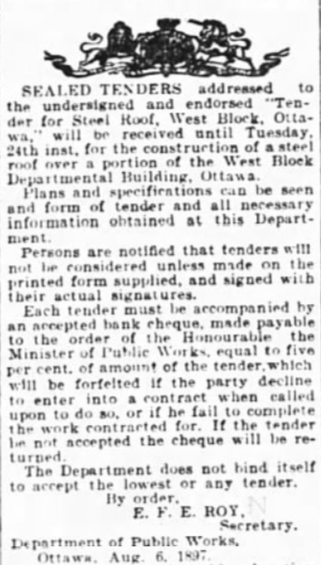 Call for tenders for repairs to West Block, Ottawa Journal, 9 August, 1897.Rebuilding became highly political. The Conservative opposition accused the government of featherbedding and hiring only Hull workers in order to curry favour with Hull voters ahead a forthcoming federal by-election in Wright Country which encompassed Hull. The Liberal candidate, Mr. Louis Napoléon Champagne, was unapologetic saying Hull wasn’t the only city that had obtained patronage as other places got their share of federal business. He added that the Liberals were prepared to do it again “to those who are really friends of Mr. Laurier.” Champagne won the contest. The day after the by-election, 50 of the 313 workers on the West Block were dismissed, with further dismissals expected in order to reduce the size of the work force to what was appropriate.
Call for tenders for repairs to West Block, Ottawa Journal, 9 August, 1897.Rebuilding became highly political. The Conservative opposition accused the government of featherbedding and hiring only Hull workers in order to curry favour with Hull voters ahead a forthcoming federal by-election in Wright Country which encompassed Hull. The Liberal candidate, Mr. Louis Napoléon Champagne, was unapologetic saying Hull wasn’t the only city that had obtained patronage as other places got their share of federal business. He added that the Liberals were prepared to do it again “to those who are really friends of Mr. Laurier.” Champagne won the contest. The day after the by-election, 50 of the 313 workers on the West Block were dismissed, with further dismissals expected in order to reduce the size of the work force to what was appropriate.
Repairs were sufficiently advanced within a year to permit public servants to re-occupy their offices. But work on the West Block was not completed until 1899, more than two years after the fire.
The West Block fire led to considerable reflection on the size of the Ottawa Fire Department and its equipment, and the extent of the fire hazard posed by public buildings, particularly those on Parliament Hill. The Citizen opined that Ottawa was “comparatively helpless in the presence of a major conflagration.” The “noble government structures,” which cost $5-6 million to build, were the “crowing beauty of the Capital of the Dominion.” Yet, the buildings, constructed using wooden beams and partitions and filled with irreplaceable records, papers and documents, were fire traps. The newspaper contended that should fire break out in either the Central Block or the East Block, “the result would be equally bad” as what had just occurred.
It added that the House of Commons was particularly at risk since the Centre Block was built on a higher elevation that the West or East Blocks which meant that water pressure would be even more of a problem. The Library of Parliament was “the most serious case of anxiety,” as it held more than $1 million in books, and contained no dividing walls. Given these risks, the newspaper was appalled that smoking was permitted and argued that smoking should be banned in all public buildings.
These were prophetic words. Virtually nineteen years to the day later, on 3 February 1916, the Centre Block was destroyed by fire. The precious Library of Parliament was the only part of the building saved, owing to the quick thinking of a librarian who had the presence of mind to close an iron fire door that separated the structure from the main part of the building.
Over the decades that followed, the West Block was much altered. In 1911, a new wing was built linking the east and west wings to form an enclosed quadrangle. During the mid-1950s, the West Block suffered from extensive renovations which were unsympathetic to the original design. However, this was better than the alternative. In 1956, the St. Laurent government almost manage to achieve which the 1897 fire had failed to do—the complete destruction of the beautiful and historic Gothic-revival building. The Federal District Commission, the fore-runner of the National Capital Commission, wanted to replace it with a modern office tower. But after a nation-wide protest, wiser heads prevailed and the building was saved. However, the neighbouring Supreme Court building was not so lucky. It was destroyed to make way for a parking lot.
Today, the enclosed quadrangle in the middle of the West Block, now covered by a glass ceiling, is the temporary home of the House of Commons while the Centre Block undergoes much needed restoration and renovation.
Sources:
Ottawa Daily Citizen, 1897. “The Western Block in a Blaze,” 12 February.
————————-, 1897. “The Second Alarm,” 13 February.
————————-, 1897. “A Present Danger,” 13 February.
————————-, 1897. “After The Fire,” 15 February.
————————-, 1897. “Their Usefulness Done,” 25 March.
————————-, 1897. “West Block Blaze,” 24 June.
————————-, 1898. “West Block Fire,” 24 March.
Ottawa Evening Journal, 1897. “The Talk of Today,” 13 February.
——————————, 1897. “The Official Report,” 17 February.
—————————–, 1897. “The Wright Campaign,” 17 March.
—————————–, 1897. “An Insult To Hull,” 18 March.
—————————–, 1897. “One Million Dollars,” 27 March.
—————————–, 1899. “West Block Repairs,” 9 August.
Privy Council Office, 1897, “Special Warrant $56,000 [sic] [$25,000], Fire, Western Departmental Buildings – Minister of Public Works,” 17 February, Library and Archives Canada.
Story written by James Powell, the author of the blog Today in Ottawa's History.
Retired from the Bank of Canada, James is the author or co-author of three books dealing with some aspect of Canadian history. These comprise: A History of the Canadian Dollar, 2005, Bank of Canada, The Bank of Canada of James Elliott Coyne: Challenges, Confrontation and Change,” 2009, Queen’s University Press, and with Jill Moxley, Faking It! A History of Counterfeiting in Canada, 2013, General Store Publishing House, Renfrew, Ontario. James is a Director of The Historical Society of Ottawa.
The Assassination of D'Arcy McGee
At our May 12th 2021 meeting, James Powell, HSO director and author of the popular blog "Today in Ottawa's History", took the audience back in time to the assassination of Thomas D'Arcy McGee, one of the Fathers of Canadian Confederation.
The Phantom Air Raid
14 February 1915
One of the most curious events in Ottawa’s history occurred on Valentine’s Day night, Sunday 14 February 1915, six months after the start of the Great War. At roughly 10.30pm, the Prime Minister, Sir Robert Borden, received an urgent telephone call from Mayor Donaldson of Brockville informing him that at least three German airplanes had crossed the St Lawrence River from Morristown, New York. The invaders, apparently seen by scores of Brockville citizens who were returning from Sunday evening church services, had just passed directly over the community travelling in a northerly direction, presumably towards the capital. One of the planes shone a powerful searchlight on the town, lighting up its main street. Reportedly, the planes dropped “fireballs,” or “light balls,” into the river on the Canadian side of the border. Many Brockville citizens become hysterical.
After receiving the mayor’s call, Borden immediately contacted the Canadian Militia. Meanwhile, Brockville’s chief of police telephoned Colonel Percy Sherwood, Commissioner of the Dominion police regarding the air invaders. At 11.15pm, Sherwood ordered Parliament Hill to be blacked out to avoid giving the raiders an easy target. While the phlegmatic Commissioner was not unduly apprehensive about the report of approaching enemy planes, he believed it expedient to take precautionary measures, including blacking-out key government buildings. The lights that illuminated the Centre block’s Victoria Tower when Parliament was in session were extinguished. The Royal Mint, which was also typically lit up at night, was similarly darkened. At Rideau Hall, home of the Governor General, the blinds were drawn. Although the Governor General was away inspecting troops in Winnipeg, his wife, the Duchess of Connaught, was in residence. Other buildings observed the black-out as news of the pending attack hit the streets. The Globe newspaper reported that the entire city of Ottawa was in darkness that night.
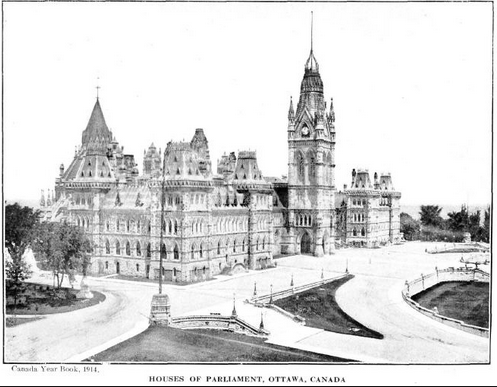 Centre Block, Houses of Parliament, Ottawa, 1914.Despite Ottawa being only 100 kilometres distant from Brockville as the crow flies, aviation experts told the Canadian authorities that it might take until midnight for the invaders to make their way to the capital owing to poor weather conditions, which included low clouds and rain. Recall that planes at that time were lucky to go much more than 100 kilometres per hour under favourable conditions. Smith Falls, Perth, and Kempville, which were on the expected flight path, were alerted, and told to keep a sharp look-out. But midnight came and went without any sign of the intruders.
Centre Block, Houses of Parliament, Ottawa, 1914.Despite Ottawa being only 100 kilometres distant from Brockville as the crow flies, aviation experts told the Canadian authorities that it might take until midnight for the invaders to make their way to the capital owing to poor weather conditions, which included low clouds and rain. Recall that planes at that time were lucky to go much more than 100 kilometres per hour under favourable conditions. Smith Falls, Perth, and Kempville, which were on the expected flight path, were alerted, and told to keep a sharp look-out. But midnight came and went without any sign of the intruders.
The next day, newspapers were full of stories on the putative air raid. The Globe’s headline screamed: “Ottawa In Darkness Awaits Aeroplane Raid. Several Aeroplanes Make A Raid Into The Dominion Of Canada.” In the streets of the capital, citizens experienced a frisson of excitement with the war apparently being brought to the city. The Ottawa Journal reported that “Ottawa feels first thrill of war,” and marvelled that usually reserved Ottawa citizens were stopping complete strangers on the street seeking news of the invaders. In the House of Commons, Sir Wilfrid Laurier rose and asked the Prime Minister for any information that he might be able to provide. Borden confirmed that he had received a telephone call from the Mayor of Brockville, and that he had communicated the news of the expected raid to the chief of the general staff, but he was “unable to give the point of departure of the aeroplanes in question.” That night, fearing that the previous night’s attack might have been aborted owing to bad weather and subsequently re-launched, government buildings were blacked out for a second night. Parliament sat as usual, but behind drawn curtains.
For two hours, Ottawa’s city council debated a motion submitted by St George Ward alderman Cunningham “that in view of the possibility of an air raid on the city hall while this august body is in session, Constable McMullen be instructed to pull down the blinds.” The Ottawa Journal wryly noted that the debate occurred under the glare of 61 electric lights which lit up the building. It also noted that the alderman frequently absented himself from the debate to climb the city hall tower to scan the skies for sight of the approaching planes so that he could be the first to warn his colleagues to take shelter in the cellar.
When no planes appeared, people started to look for other explanations. Quickly, suspicion focused on some Morristown youths, described as “village cut-ups,” who admitted to having sent up three “fireworks balloons” from the American side of the St Lawrence at about 9pm which exploded in the air above Brockville. Giving credence to this story, the remains of balloons with firework attachments were subsequently recovered from the ice on the St Lawrence two miles east of the town, as well as from the grounds of the Brockville Asylum, now called the Brockville Mental Health Centre. The ostensible reason for sending up the balloons was to commemorate the centenary of the end of the war of 1812. More likely it was a prank aimed at scaring Canadians.
Officials in Ottawa didn’t readily believe these reports. The Dominion Observatory reported that the wind that night was consistently coming from the east. It contended that as Morristown is directly opposite Brockville, any balloons sent up from the Morristown area would have travelled to the west, and certainly not in the direction the airplanes were said to have taken. The press also reported that militia authorities were in contact with Washington, and that a thorough inquiry had been set in motion to locate the airplanes’ base of operation.
Across the Atlantic in England, which had experienced its first German Zeppelin air raid just three weeks earlier, the phantom air raid on Ottawa was a source of merriment. By chance, the night after the Ottawa scare, the lights of Parliament at Westminster suddenly went out. Making a reference to the Ottawa raiders, William Crooks, Labour MP for Woolwich cheekily called out in the darkness” “Hello, they’re here!” The House of Commons cracked up with laughter.
So what really happened that Valentine’s Day night? How plausible was an attack on Ottawa?
It wouldn’t have been the first time that armed raiders had crossed the U.S. border into Canada. There were precedents. Less than fifty years earlier, the Fenians, an Irish extremist group, made a number of military forays into Canada across the U.S. border. The Ottawa Journal also claimed that German sympathizers in the United States had contemplated action against Canada during the early days of the war in 1914, going so far as to set up training bases in the United States with the objective of “making a descent upon Canada to destroy canals and railways” before being told to desist by U.S. authorities. Less than two weeks prior to the supposed air raid on Ottawa, Werner Horn, a German army reserve lieutenant, tried to blow up the Vanceboro international bridge between St Croix, New Brunswick and Vanceboro, Maine in an attempt to disrupt troop movements.
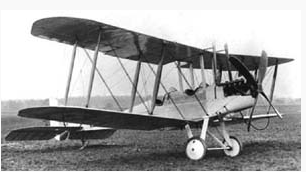 British B.E.2c, manufactured by the British Air Factor, Vickers, Bristol, circa. 1914.However, an air raid on Ottawa by German sympathizers seems highly unlikely. While on a sharp upward development trajectory, aviation was still primitive in early 1915, the first powered flight having taken place only eleven years earlier. Even at the front in France, airplanes were then mostly used for reconnaissance. Typical of that era, the British military airplane, the B.E.2c, could stay aloft for only three hours.
British B.E.2c, manufactured by the British Air Factor, Vickers, Bristol, circa. 1914.However, an air raid on Ottawa by German sympathizers seems highly unlikely. While on a sharp upward development trajectory, aviation was still primitive in early 1915, the first powered flight having taken place only eleven years earlier. Even at the front in France, airplanes were then mostly used for reconnaissance. Typical of that era, the British military airplane, the B.E.2c, could stay aloft for only three hours.
The most likely explanation is the toy balloon story, combined with a bad case of war jitters. As suggested by one of the newspapers, the searchlight beam that reportedly lit up Brockville could be explained by a fortuitous flash of lightning while the balloons were above the city. However, the fact that the Dominion Observatory was adamant in its view on the wind direction that night fuelled fears that the bombers were real.
Certain modern-day investigators have a whole different explanation—UFOs. The story of Ottawa’s phantom air raid has featured in a number of books on the paranormal, including The Canadian UFO Report: The Best Cases Revealed. To add grist to the paranormal mills, the same night Ottawa prepared for an air raid, strange lights and planes were apparently spotted over other Ontario towns.
Sources:
Colombo, John Robert, 1999. Mysteries of Ontario, Hounslow Press.
House of Commons, 1915. “Reported Appearance of Aeroplanes,” Twelfth Parliament, Fifth Session, Volume One, 15 February.
Rutkowski, Chris & Dittman, Geoff, 2006. The Canadian UFO Report: The Best Cases Revealed, University of Toronto Press, Toronto.
The Globe, 1915. “Ottawa In Darkness Awaits Aeroplane Raid,” 15 February.
————————, 1915. “Were Toy balloons and not Aeroplanes!” 15 February.
The Ottawa Journal, 1915. “House To Be Dark Again To-night,” 15 February.
————————, 1915. “Wind From East; Fact That Casts Doubt On Toy Balloon Story; But It Seems Most Likely Explanation,” 15 February.
———————-, 1915. “The Air Raid That Didn’t,” 15 February.
———————–, 1915, “Brockville Statement,” 15 February.
———————–, 1915. “Laughing at Ottawa,” 16 February.
Unikoshi, Ari, 2009. The War in the Air, http://www.firstworldwar.com/airwar/summary.htm.
This email address is being protected from spambots. You need JavaScript enabled to view it.. 2007. “The Phantom Invasion of 1915,” Rootsweb, Quebec-Research Archives, http://archiver.rootsweb.ancestry.com/th/read/QUEBEC-RESEARCH/2007-04/1176680122.
Images:
Statistics Canada. Parliament, 1914. http://www65.statcan.gc.ca/acyb07/acyb07_2014-eng.htm.
British B.E.2c, circa 1914, http://en.wikipedia.org/wiki/Royal_Aircraft_Factory_B.E.2.
Story written by James Powell, the author of the blog Today in Ottawa's History.
Retired from the Bank of Canada, James is the author or co-author of three books dealing with some aspect of Canadian history. These comprise: A History of the Canadian Dollar, 2005, Bank of Canada, The Bank of Canada of James Elliott Coyne: Challenges, Confrontation and Change,” 2009, Queen’s University Press, and with Jill Moxley, Faking It! A History of Counterfeiting in Canada, 2013, General Store Publishing House, Renfrew, Ontario. James is a Director of The Historical Society of Ottawa.
Queen Victoria Chooses Ottawa
31 December 1857
Almost everybody knows that Queen Victoria selected Ottawa as Canada’s capital. But few are aware that the city’s selection was anything but a genteel affair. In fact, the Queen was only asked to help after years of sterile political wrangling between contending factions in Parliament. There were more than 200 votes on the issue. Even after the Queen had made her choice, it didn’t go down well with some and was challenged in Parliament. At the end of the day, Canadian legislators only narrowly ratified the Queen’s decision; a change of three votes from yea to nay would have nixed it.
It all began with the merger of Upper and Lower Canada to create the united Province of Canada in 1841 consisting of Canada West (Ontario) and Canada East (Quebec), each equally represented in Parliament, under the joint leadership of a premier from each of the two Canadas. The Governor-General, Lord Sydenham, convened the first opening session of the united parliament at Kingston on 14 June 1841. While Kingston residents were delighted to be living in the de facto capital of Canada, others were less enamoured with Lord Sydenham’s choice. Canada East representatives had hoped that either Quebec or Montreal would have been chosen as both were far larger in population and had more to offer in the way of amenities for debate-weary members of parliament. However, Canada West was insistent on hosting the new capital. As Kingston satisfied Canada West’s requirement, Canada East representatives reluctantly acquiesced on the grounds that at least it wasn’t Toronto.
But Toronto-area MPs weren’t satisfied either. They submitted a bill calling for Parliament to meet alternatively in the old capitals of Toronto and Quebec City. This bill passed though the outcome satisfied few. MPs agreed in 1842 to examine three resolutions each favouring a different city as the permanent capital—Montreal, Toronto, or Bytown, as Ottawa was then called. All motions were defeated, with Bytown receiving the fewest votes, only 6 for against 57 opposed.
In 1843, Canada’s Attorney General moved that Montreal be chosen as the capital. This motion passed on a vote of 55 to 22. Toronto and Quebec City were rejected as being too far from the geographic centre of the newly united Province of Canada. Bytown too failed despite its favourable geographic attributes—it bordered both provinces, was pretty much equidistant between Toronto and Quebec, and was located at the mouth of the militarily important Rideau Canal, safely distant from the United States. But politicians and bureaucrats looked in horror at the idea of decamping to an isolated “Arctic lumber village,” with a population of perhaps 5,000. Its tumbledown wooden buildings offered few creature comforts, especially in the midst of a harsh Canadian winter. Cosmopolitan Montreal was a far better choice. There, public servants could enjoy the social and commercial attractions of a well-established city that boasted a population ten times that of Bytown. It was also located on the St. Lawrence, Canada’s vital trade route to the Atlantic.
In November 1844, after months of renovations to St. Anne's Market to accommodate Parliament, the capital moved from Kingston to Montreal. Montreal had seemingly won the day. However, less than five years later, Montreal blotted its copy book when a mob protesting the passage of the Rebellion Losses Act that compensated “rebels” as well as “loyalists” for property destroyed in the 1838 Rebellion burnt down Canada’s Parliament buildings. Reconvening in Toronto, politicians decided against returning to unstable Montreal and instead agreed once again that Parliament would alternate between Toronto and Quebec City. This was a patently nutty decision given the difficulty and cost of moving Parliament and its supporting bureaucrats and files every few years—the Grand Trunk Railway linking Toronto to Quebec had yet to be built.
In 1854, Sir Richard Scott, the mayor of Bytown and later member of the Legislative Assembly for Ottawa, renewed the campaign to make Bytown the capital. In 1856, Canada’s Attorney General moved for a definitive selection of a permanent capital. MPs were given a choice between Toronto, Hamilton, Quebec, Montreal, Kingston, and newly re-named Ottawa. In a veritable blizzard of motions for and against each city, Quebec City emerged the victor by a vote of 64 to 56. The lower house also voted in favour of providing £50,000 ($250,000) to fund the construction of new legislature buildings. Unfortunately, the Legislative Council (equivalent to today’s Senate) refused to support the funding. No funding meant no capital for Quebec City.
The political impasse continued into 1857. In a series of motions, Ottawa garnered only 11 supporters out of a 130-member house though no other city could attract a majority. To break the impasse, a resolution asking Queen Victoria to make the choice passed the Legislative Assembly, though only over stiff opposition by members who considered royal mediation as undermining the Canadian government’s newly-gained responsibility for domestic affairs. The mayors of Toronto, Montreal, Ottawa, Kingston and Quebec City subsequently received letters from the Governor-General, Sir Edmund Head, asking them to prepare papers setting out their respective cities’ merits.
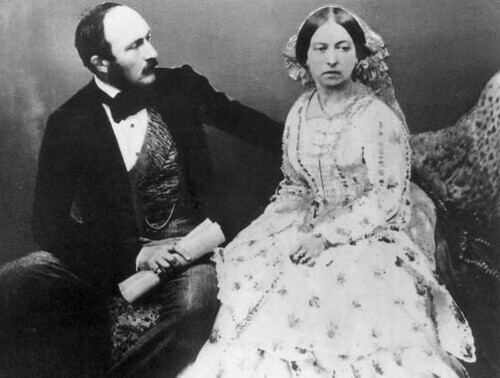 Queen Victoria and Prince Albert, 1854. Photo by Roger Fenton.This set in motion feverous activity in candidate cities. In Ottawa, the City Council set up a special meeting of leading citizens, including Sir Richard Scott and Mr. R. J. Friel, to draft a memorial to the Queen setting out Ottawa’s many advantages. Other cities did likewise. Kingston, Montreal and Quebec also sent delegations to London to lobby for support. In the end, Ottawa won the day, a choice favoured by the Governor General. Some say that Ottawa also received unofficial support from Lady Head, the G-G’s wife, who apparently was a good friend of the Queen. The story goes that the Heads had been invited to a picnic lunch in Ottawa held at what would later become Major’s Hill Park. Enchanted with the area and its wonderful river views, Lady Head, an amateur watercolourist, made a number of sketches that she shared with the Queen. Ottawa apparently had other high placed supporters, including Prince Albert, Queen Victoria’s Consort.
Queen Victoria and Prince Albert, 1854. Photo by Roger Fenton.This set in motion feverous activity in candidate cities. In Ottawa, the City Council set up a special meeting of leading citizens, including Sir Richard Scott and Mr. R. J. Friel, to draft a memorial to the Queen setting out Ottawa’s many advantages. Other cities did likewise. Kingston, Montreal and Quebec also sent delegations to London to lobby for support. In the end, Ottawa won the day, a choice favoured by the Governor General. Some say that Ottawa also received unofficial support from Lady Head, the G-G’s wife, who apparently was a good friend of the Queen. The story goes that the Heads had been invited to a picnic lunch in Ottawa held at what would later become Major’s Hill Park. Enchanted with the area and its wonderful river views, Lady Head, an amateur watercolourist, made a number of sketches that she shared with the Queen. Ottawa apparently had other high placed supporters, including Prince Albert, Queen Victoria’s Consort.
The Queen received all the documents by October 1857. After reviewing the material sent to her and consulting with her advisers, she selected Ottawa. Her decision was officially relayed to Canada’s Governor General by Henry Labouchere, the Colonial Secretary, in a letter dated 31 December 1857.
This did not end the debate, however. A motion asking the Queen to reconsider her decision was introduced in July 1858 by the opposition led by The Globe newspaper’s radical editor George Brown. The opposition motion passed the House by a vote of 64 to 50. Then things got really weird. The defeated Conservative-led government of John A. Macdonald and George Étienne Cartier, his Canada East confederate, resigned, howling that the opposition motion was an affront to the Crown. With George Brown and his Canada East ally, Antoine-Aimé Dorion, assuming power, it looked like Ottawa’s hopes to be the capital were to be dashed. But the Brown-Dorion government fell after only four days.
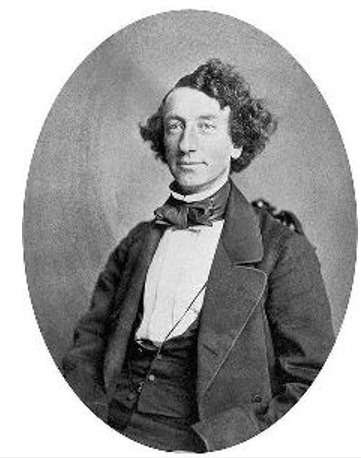 J. A. Macdonald, 1858. Unknown photographer.Under the legislative rules of the day, newly appointed Cabinet ministers were obliged to resign their parliamentary seats and seek re-election before assuming their positions. Brown’s newly minted ministers duly resigned following their appointments. In a snap vote of no confidence, Macdonald and Cartier defeated the new Brown-Dorion administration shorn of its Cabinet ministers. When the Governor General refused to call a general election, Brown resigned, and Macdonald and Cartier were asked back to form a government.
J. A. Macdonald, 1858. Unknown photographer.Under the legislative rules of the day, newly appointed Cabinet ministers were obliged to resign their parliamentary seats and seek re-election before assuming their positions. Brown’s newly minted ministers duly resigned following their appointments. In a snap vote of no confidence, Macdonald and Cartier defeated the new Brown-Dorion administration shorn of its Cabinet ministers. When the Governor General refused to call a general election, Brown resigned, and Macdonald and Cartier were asked back to form a government.
Everybody thought that Macdonald and his new ministers would also resign their seats and seek re-election, leaving the new Conservative government at Brown’s mercy. But, taking advantage of another Parliamentary rule that allowed ministers to change portfolios within a 30-day period without having to seek re-election, Macdonald simply appointed the ministers in his old government to different Cabinet posts before reshuffling them back to their original positions. Macdonald, temporarily Postmaster General, ended up as Deputy Premier rather than Premier in the new government. It seems that the Governor General was worried about the optics of Macdonald regaining the premiership and insisted that Cartier become Premier, at least officially. This sneaky, or brilliant (depending on your point of view), political manoeuvre became known as “The Double Shuffle.” With Brown-Dorion out and MacDonald-Cartier back in, Ottawa’s prospects were restored.
There was one more vote to ratify Queen Victoria’s decision. Held in early 1859, the vote in favour of Ottawa squeaked through with a majority of only five votes.
Sources:
City of Ottawa, 2014. A Virtual Exhibit: Ottawa Becomes the Capital, http://ottawa.ca/en/residents/arts-culture-and-community/museums-and-heritage/virtual-exhibit-ottawa-becomes-capital-0.
Joseph Edmund Collins, 1883. Life and Times of the Right Honourable Sir John A. Macdonald, Rose Publishing Company, Toronto.
Gwyn, Richard, 2007. The Man Who Made Us: The Life and Times of Sir John A. Macdonald. vol 1: 1815-1867. Random House Canada.
Hamnett P. Hill, K.C., 1935. “The Genesis of our Capital,” Bytown Pamphlet Series #3, Ottawa Historical Society.
The Ottawa Evening Citizen 1925. “How Ottawa Was Chosen The Capital of The Dominion,” 25 June.
——————, 1930. “When Queen Victoria Made Ottawa Capital,” 22 May.
Public Works and Government Services Canada, 2013. “Parliament Hill, Pre-construction, 1826-58,” http://www.tpsgc-pwgsc.gc.ca/collineduparlement-parliamenthill/batir-building/hist/1826-1858-eng.html.
Image: J. A. Macdonald, 1858, unknown, File:John A Macdonald in 1858.jpg - Wikipedia
Image: Queen Victoria and Prince Albert, 1855, Roger Fenton, http://www.robswebstek.com/2009/04/queen-victoria-prince-albert-1855.html.
Story written by James Powell, the author of the blog Today in Ottawa's History.
Retired from the Bank of Canada, James is the author or co-author of three books dealing with some aspect of Canadian history. These comprise: A History of the Canadian Dollar, 2005, Bank of Canada, The Bank of Canada of James Elliott Coyne: Challenges, Confrontation and Change,” 2009, Queen’s University Press, and with Jill Moxley, Faking It! A History of Counterfeiting in Canada, 2013, General Store Publishing House, Renfrew, Ontario. James is a Director of The Historical Society of Ottawa.
Discoveries Unearthed Prior to the Renovations on Parliament Hill
Wow! Did you miss our virtual Speaker Series presentation "Uncovering Canada's Past: Digging Up Parliament Hill" with Stephen Jarrett? What an amazing presentation it was!
The good news is... here is the video link to enjoy Stephen's talk in its entirety!
Our apologies to those who were unable to attend Stephen's presentation due to Zoom's 100 attendee limit. We had processed the request to increase attendance but we seem to have experienced a technical glitch.
We're so sorry! The November 2020 presentation was our third foray into the new world of virtual talks and we're still learning the ropes. We hope you enjoy this recorded version of this excellent talk:
Tree Trouble in Ottawa’s Urban Forest
At the Historical Society of Ottawa November 2019 afternoon meeting, Joanna Dean, a Carleton University history professor, described to listeners the Trouble With Trees. While being a lover of trees, Joanna acknowledged that trees sometimes do cause the city and its residents problems.
William Saunders, the first director of the Experimental Farm was instrumental in promoting elm trees. Many were planted on King Edward Avenue and Clemow Avenue. However, in 1903, 1922, and 1932 reports, city engineers described problems that trees were causing to infrastructure. They heaved sidewalks, grew into the sewers, and tangled with a “multiplicity of poles carrying wires for telephone, telegraph, electric light, electric railway, and fire alarm services.” Various city utility companies took turns butchering the trees. It is estimated that 4,000 trees were removed between 1921 and 1945.
A shift came in the 1960s when Dutch elm disease came to Ottawa. It devastated these tall, stately trees. The dead elms had to be removed. The streets looked barren and empty. A city-wide planting campaign was put in place, 2600 trees were planted in 1961, compared to 24 trees planted in 1944.
The white birch is another popular city tree. During construction of the Parliament Buildings in the 1860s, the bluffs along the river were a handy dumping place for refuse and rubble. To make the bluffs accessible to the public a walkway, named Lover’s Walk, was built in the late 1800s that wound along the sides of the hill. The walk became a major tourist attraction. White birches were planted in the early 1900s. Birches are a pretty tree but are susceptible to disease and didn’t do well. People pulled bark off, the canopy was thin, the roots were exposed, and caterpillars were identified. The trees were struggling. In the end the walk was closed. The birches died out.
Lombardy poplars were planted in the Glebe, bordering Central Park. They are fast growers, up to six feet in a year, and a great shade tree. So fast and so shady that they caused consternation with the neighbours. Some of whom complained to the Federal District Commission, now the NCC, for years. A few were cut down to limit the complaints. Trees cause trouble. Political trouble.
Crab apple trees were planted as the 1967 Centennial tree, a declared war on ugliness, a Made in Canada solution. They were and are a very pretty tree. But they are so susceptible to disease that even Trevor Cole who managed the arboretum in the Central Experimental Farm singles them out as trees that should not be planted.
Bur oaks are native to Canada and to the Ottawa area. Champlain described them when he came up the Ottawa River. The Deschênes Rapids are named after them. They can live up to 300 years. When one that is a mere 150 years old was approved by the city to be removed in Champlain Park to make room for a house expansion it impacted the neighbourhood. It was taken down. Joanna obtained a cookie from the trunk and counted the rings. It was 158 years old.
From the human perspective, trees cause problems. We need to remember that from the trees perspective they are simply pursuing their own agenda.
Lover's Walk
14 May 1938
When visitors come to Ottawa, they naturally gravitate to Parliament Hill to view the magnificent neo-Gothic Parliament Buildings, to stroll in the surrounding gardens where statues and memorials to Canadian sovereigns and statesmen abound and, of course, to take in the stunning views across the Ottawa River towards Hull and the Gatineau Hills. One hundred years ago, the number two Ottawa tourist destination was Lovers’ Walk—a pathway that wended its way around the Parliament Hill bluff roughly half-way up the escarpment. Surrounded by a hardwood forest and flowering shrubs, including lilacs and honeysuckle, the pathway commanded splendid views of the Ottawa River, with benches for the weary or for the amorous. Visitors to this tranquil wilderness could easily forget that they were in the heart of Canada’s capital city. According to a 1920s’ guide book, anyone who has not taken a stroll there “has not seen all the charms of the capital. In fact, he has missed one of the greatest of them.” Fast forward to today, you would be hard pressed to find an Ottawa resident who has any knowledge about this once-famous pathway.
The history of Lovers’ Walk apparently dates back long before the arrival of the first Europeans to the Ottawa Valley. Accounts say that the pathway was used by Canada’s native peoples travelling along the southern banks of the Ottawa River. During the first half of the nineteenth century, raftsmen took this same route as a short cut moving to and from their homes in Lower Bytown and the timber chutes at the Chaudière Falls. Sometime after Confederation in 1867, the rough path was widened, decorative iron railings were fitted to protect users from falling, and staircases were installed at several points to give the general public ready access.
One story says that William Macdougall, the Minister of Public Works from 1867-69 in Sir John A. Macdonald’s first Dominion government, was responsible for upgrading the trail from a rough, dangerous track to a gentle path that even women dressed in the long gowns of the period could stroll along without fear of tripping. Macdougall, who was apparently a “hands on” type of Minister, stumbled upon the footpath when he was inspecting the construction of a ventilation shaft for the Centre Block on Parliament Hill.
Another story gives the credit for Lovers’ Walk to Thomas Seaton Scott, the Dominion Chief Architect from 1872-1881. Seaton was responsible for laying out the structured gardens that surround the Parliament Buildings as well as designing the Drill Hall on Elgin Street. According to this account, Seaton constructed the steps down from the formal gardens on top of Parliament Hill to allow the general public access to the wilder charms of the pathway.
Who actually came up with the name Lovers’ Walk is unknown. The first newspaper reference to this name appears in the Ottawa Daily Citizen in 1873. A visitor at about this time said that “no more appropriate name could be devised.”
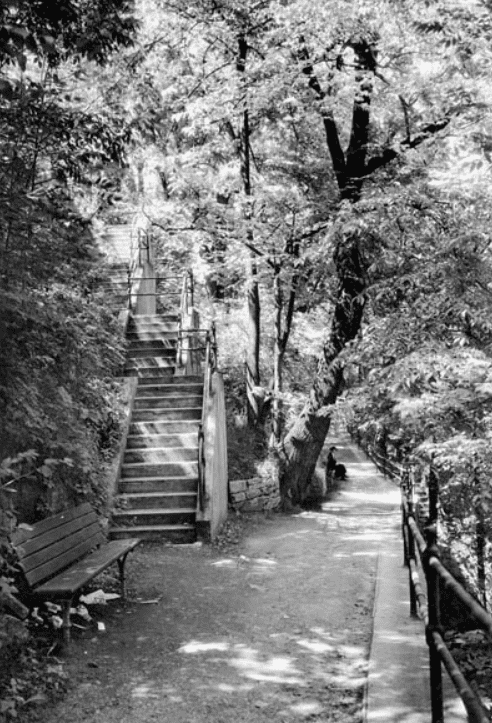 Steps down to Lovers’ Lane, Parliament Hill, Dept of the Interior, Library and Archives Canada, PA-034227, circa 1920s.
Steps down to Lovers’ Lane, Parliament Hill, Dept of the Interior, Library and Archives Canada, PA-034227, circa 1920s.
In addition to tourists and Ottawa residents, the denizens of Parliament on top of the bluff also took advantage of the pathway, seduced by Lovers’ Walk’s winsome charms. Prime Ministers, Cabinet Ministers, Senators and ordinary Members of Parliament were all known to take breaks from the hard work of politicking to refresh themselves with a stroll through its sylvan beauty. Lovers’ Walk also attracted bird watchers. One avid amateur naturalist in the early 1930s spotted 59 different species from the pathway.
Lovers’ Walk could be accessed from either side of the Parliament Buildings. On the eastern side, there was a flight of stairs leading from roughly where the equestrian statue of Queen Elizabeth stands today. Another flight of stairs started from a location behind the Bytown Museum close to the locks on the Rideau Canal. On the western side of Parliament Hill at the end of Bank Street, behind the old Supreme Court of Canada, which was demolished in 1956, strollers entered the Walk through a stone gateway. Midway on the path there was a lookout with benches for those wanting to stop to rest or admire the views. There was also a lion-headed water fountain to refresh the thirsty. Unfortunately, strollers and lovers sometimes came across less-savoury elements who also frequented Lovers’ Walk. In 1875, there was a call for police to exclude “roughs” who amused themselves by throwing burrs onto ladies’ dresses. It was also advisable not to pick the flowers. In 1931, Mrs Pamela Cummings of 726 Cooper Street was fined $3 plus $2 court costs for stealing lilacs.
Lovers’ Walk was closed in the winter owing to snow and ice that made walking dangerous, but re-opened each spring, typically in May, once conditions were suitable. Given the steep nature of the hillside, there were frequent rockslides that were dealt with by the Department of Public Works. At the start of the First World War, the pathway was closed to the public and was patrolled by the Dominion Police. The authorities feared that German saboteurs could use Lovers’ Walk to access the ventilation shafts that aired the Centre Block. By cutting the iron protective grills, saboteurs could potentially plant explosives under the building and blow up Parliament. These precautions were discontinued after the Centre Block was destroyed by fire in February 1916.
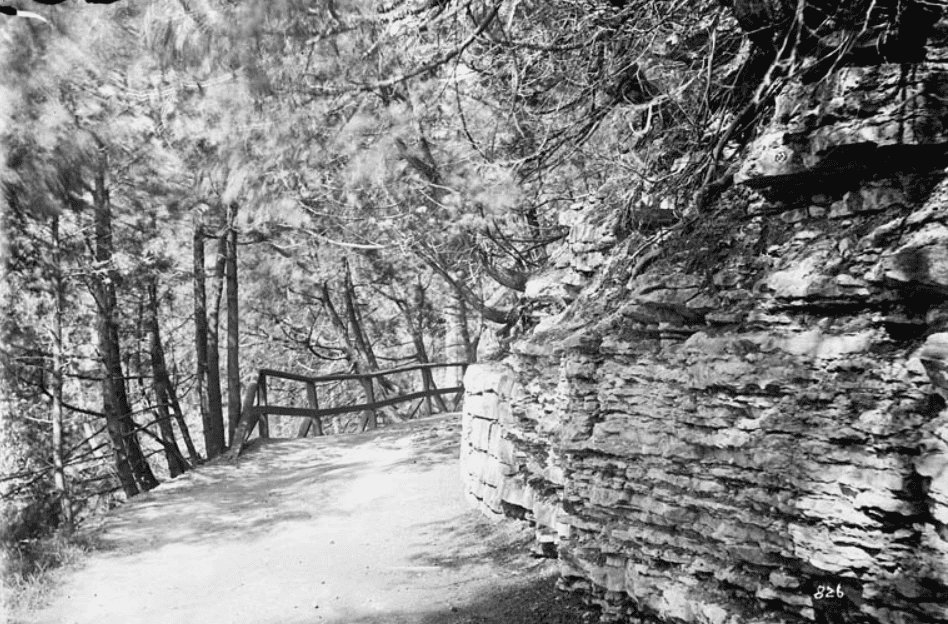
By the 1930s, Lovers’ Walk was becoming less popular. With the Depression at its peak, the pathway had become the haunt of panhandlers and the homeless, and was considered unsafe for casual strollers. The Ottawa Journal reported that “the dregs of humanity would pan handle the lovers, even seek to molest them.” A “jungle” of tin-patched shacks built by homeless men sprung near the path close to the western entrance. The eastern end, close to the Canal locks, was described as the haunt of drunks whose wild shouts could be heard from men drinking denatured alcohol. Regular police patrols and RCMP efforts to dismantle the shacks did little. There were also dark allegations of immorality.
In the winter of 1937-38, two landslides washed out more than sixty feet of Lovers’ Walk. It never officially re-opened. On 14 May 1938, the Ottawa Citizen reported that to repair the pathway would cost over $30,000. Although the Senate Standing Committee on Public Buildings and Grounds, chaired by Cairine Wilson, recommended that the Department of Public Works take steps to stabilize the cliff face and reopen Lovers’ Walk, the repairs were not undertaken. During a time of depressed economic conditions, $30,000 was simply too much.
Besides landslides and the presence of “undesirables,” another possible factor behind the closure of Lovers’ Walk was concerns about Government liability. In 1933, a young boy had climbed over a gate when Lovers’ Walk was closed for the winter. He slipped on the ice, fell 50 feet, and was lucky to get away with only a broken femur. His father unsuccessfully tried to sue the government for his doctor’s bill. In 1937, a man, who had been sitting on a guard railing, broke his spine when he lost his balance and plunged down the cliff.
Some say that it was Prime Minister William Lyon Mackenzie King who ordered the closure of Lovers’ Walk. However, another account says that King had wanted to keep it open and that it was only following extensive discussions with the RCMP, Public Works, and the Speakers of both the Senate and the House of Commons that the decision to close it was reluctantly taken. High barricades were installed at both ends to stop people from using the path now deemed unsafe.
By the 1950s, Lovers’ Walk was a “desolate ruin of crumbling masonry, rusted and broken iron guardrails and rotten wooden shoring.” What was left of the pathway was overgrown and narrowed by erosion. Empty bottles, and other refuse littered the place—evidence that the deteriorating ruins of Lovers’ Walk remained a refuge for the homeless sleeping rough during the summer months. After an intoxicated painter fell to his death in 1960, a coroner’s jury recommended that what was left of the pathway be destroyed to ensure public safety.
Nothing was done. The area got a fearsome reputation, especially at night. By the late 1960s, secretaries and clerical staff working late on Parliament Hill were fearful of using the stairs, which cross Lovers’ Walk, to get to the parking area known as “the Pit,” despite, according to the Ottawa Journal, “routine flushing out by the RCMP foot patrols of winos, ‘rub-a-dubs,’ vagrants and, more recently, hippies from their dormitory-pad along Lovers’ Walk.” In July 1968, ex-MP Herman Laverdière was stabbed and robbed by hooligans when he went to investigate a scream that had emanated from the wooded area after he left his office at 11 pm.
Notwithstanding the increasingly bad press, there were attempts during the 1960s to restore Lovers’ Walk to its former glory. Members of all major parties championed the pathway at various times. But with the price tag rising steadily, the government in power always demurred owing to the difficulty in controlling erosion on the escarpment. In the 1980s, when Jean Pigott was Chair of the National Capital Commission, there was another look at restoring the pathway. Again, it was deemed too expensive. In 2000, the Department of Public Works looked at rebuilding the pathway given the historic nature of Lovers’ Walk and the magnificent views of the Ottawa River. Again, the issue was put on the back burner.
Most recently, LANDinc was commissioned by Public Works to develop a strategy “to restore and reforest the slopes [of Parliament Hill] to ensure long-term sustainability.” Over time, invasive species, including the lilacs, would be removed and replaced by endemic shrubs and trees. In 2014, Graebeck Construction won a $4.78 million contract to rehabilitate the western slope of Parliament Hill and the perimeter wall. There was, however, no mention of re-opening Lovers’ Walk to the general public.
Sources:
Capital Gems, 2018, Lover’s Walk Ruins, http://www.capitalgems.ca/lovers-walk-ruins.html.
Canada, 1938. Senate Journals, 18th Parliament, 3nd Session, Vol. 76, p. 344, 24 June.
———-, 1960. House of Commons Debates, 24 Parliament, 3rd Session: Vol. 6, p. 6605-06, 20 July 1960.
LANDinc, 200? Parliament Hill Stabilization,” http://www.landinc.ca/escarpmentwalkway-1.
Ottawa Citizen (The), 1873. “Town Talk,” 7 July
————————-, 1875. “The Parliament Hill,” 20 March.
————————-, 1875. “The Lovers Walk,” 23 August.
————————-, 1926. “Lovers Walk As Seen In Seventies,” 24 December.
————————–, 1933. “Boy Injured On Parliament Hill,” 27 March.
————————-, 1937. “Has Romance Departed From Lovers’ Walk.” 16 January.
————————-, 1937. “When Sturdy Raftsmen Used Lovers’ Walk as Short Cut,” 6 February.
————————-, 1938. “Repair Works on Lovers’ Walk May Cost Over $30,000,” 14 May.
————————-, 1960. “Destroy Lovers’ Walk Jury’s Recommendation,” 20 May.
————————-, 1966. “Lovers find road to romance rocky on Parliament Hill,” 14 May.
————————-, 2000. “Behind the Hill: A Walk into history,” 22 May.
Ottawa Construction News, 2014. Graebeck Construction wins bid for Parliament Hill slope stabilization work, 1 February, https://ottawaconstructionnews.com/local-news/graebeck-construction-wins-bid-for-parliament-hill-slope-stabilization-work/.
Ottawa Journal (The), 1931. “Magistrate Warns Flower-Bed Vandals,” 29 May.
————————–, 1937. “Fear Spine May Be Broken,” 15 June.
————————–, 1938. “Sweethearts Missing Famous Lovers’ Walk,” 18 July.
————————–, 1939. “May Not Re-open Lovers’ Walk,” 26 May.
————————–, 1939. “Remember When?” 8 July.
————————–, 1942. “Lovers’ Walk Ruled ‘Dangerous,’ It Won’t Be Reopened,” 31 July.
————————–, 1968. “Perils of ‘The Pit’ Worry Hill Security Staffs,” 12 July.
Urbsite, 2009. Lovers’ Walk,” http://urbsite.blogspot.com/2009/12/lovers-walk.html, 29 December.
Windsor Star (The), 1952. “Today in Ottawa,” 23 August.
Story written by James Powell, the author of the blog Today in Ottawa's History.
Retired from the Bank of Canada, James is the author or co-author of three books dealing with some aspect of Canadian history. These comprise: A History of the Canadian Dollar, 2005, Bank of Canada, The Bank of Canada of James Elliott Coyne: Challenges, Confrontation and Change,” 2009, Queen’s University Press, and with Jill Moxley, Faking It! A History of Counterfeiting in Canada, 2013, General Store Publishing House, Renfrew, Ontario. James is a Director of The Historical Society of Ottawa.




